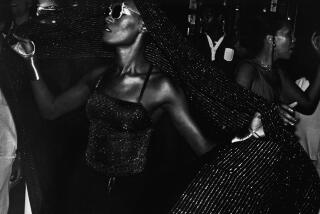New releases of old recordings prove newer is not always better
If the volume of new music available daily from around the world weren’t enough, a whole other equally vast pool of sounds in 2013 actively competed for ears and dollars: those resurrected from eras past.
Archival recordings — a combination of reissues, curated collections and expansive overviews — tapped into the reserves, at times striking pockets containing as much energy as the work of teenage rappers. Some were buried beneath so many layers of history, politics and dismissive critical judgment that it’s a wonder it survived.
The best of them seem to ask as many questions as they answer. For example, is there gold to be found in the critically maligned genre of New Age music? How could a Wisconsin furniture company end up making some of the most crucial recordings of the early 20th century? And who is William Onyeabor?
GRAPHIC: Best of 2013 | Entertainment and culture
The below list, a mere sampler of this year’s great offerings, answers these questions and more while proving that new isn’t always better.
The Beatles, “On Air: Live at the BBC Vol. 2.” (Apple/Capitol). The Beatles were, first, a rock and roll band, and the evidence of this is all over this killer collection of riffs, choruses, screams, guitar solos and mop-shaking classics captured from 1962-1965. Filled with tight takes of all the early jams, between-song banter, radio bumpers and the blossoming Beatles charm, this double disc made for broadcast on the BBC underscores the power of the music. Doubt it? Check out “Hippy Hippy Shake.”
Marianne Faithfull, “Broken English” Deluxe (Universal Music). This reissue of a junked-out Marianne Faithfull’s ragged but funky post-disco gem from 1979 hasn’t lost a lick of its power. Remastered to resurrect some of the deeper tones, “Broken English” fuses reggae with synthesizers and guitars to create a powerful, if grim, tone. Included is a second disc featuring the dance remixes and the original studio mixes — the latter focusing more on guitar riffs and less on synthesizer warbles.
Sid Hemphill, “The Devil’s Dream: Alan Lomax’s 1942 Library of Congress Recordings” (Global Jukebox). Mysterious and little documented Mississippi singer Sid Hemphill never released commercial recordings, but the raw sounds that archivist Alan Lomax made reveal an unsung master of the region. Featuring drum and fife songs, tribal hollers and, most shocking for the time, a wildly thick dose of bass-heavy percussion, the best of these recordings — “Hog Hunt,” “The Carrier Line” and “Sidewalks of New York” — contain beats and energy as aggressive and minimal as those on Kanye West’s “Yeezus.”
PHOTOS: Roberts’ best albums of 2013
Laraaji, “Celestial Music 1978-2011” (All Saints). New Age music has in recent years been given a reexamination, and lo, some of it is good. The mesmerizing music of Laraaji, in fact, sounds strikingly fresh. A number of the zither player’s most notable works are being reissued, but this two CD collection is a perfect intro, offering extended, and often beguiling, meditations such as “Lotus Collage,” “Sun Zither,” “Airbass” (with Bill Laswell) and, best, the heavy “Astral Jam,” with Blues Control. Warning: There is indeed a song called “Unicorns in Paradise” within.
Harry Nilsson. “The RCA Albums Collection” (Sony Legacy). Those wanting to get comprehensive fast should consider spending that whole gift card on Harry Nilsson, whose astounding and oft-overlooked 1960s and ‘70s output — best known are his versions of “Everybody’s Talkin’” and “Coconut” — the late singer receives renewed attention via “The RCA Albums Collection.” Featuring 17 CDs comprising his 14 albums for the label and three discs of outtakes, it’ll fill your 2014 with a ready-made love affair and Nilsson’s immediately identifiable tone.
William Onyeabor, “Who Is William Onyeabor?” (Luaka Bop). Few songs old or new in 2013 were both as joyous and as devastating as William Onyeabor’s dancefloor banger “Atomic Bomb,” from a compilation of the Nigerian artist’s unique mesh of African beats, disco, synthesizers and funk. The album’s title is to be taken seriously: Little actual biography is known of the singer, who on becoming a born-again Christian in the mid-’80s left his musical life and recordings behind. History, however, is having none of it: This stuff, made in the ‘70s and ‘80s, is evidence of, not an obstacle to, divinity.
Public Image Ltd. “First Issue” (Light in the Attic). John Lydon’s first post-Sex Pistols album was never officially issued in America, but three decades later Light in the Attic has corrected this. “First Issue,” in the scheme of things, is more important to the history of punk as Lydon’s work as Johnny Rotten. Deep, minimal dub-inspired post-disco, “First Issue” wallows within a bass abyss way more scary than empty threats of anarchy.
Sly and the Family Stone, “Higher” (Sony Legacy). Four discs that document the rise and fall of a genius, “Higher” confirms the rush that Sylvester “Sly Stone” Stewart generated in creating masterpieces, including “There’s a Riot Goin’ On,” “Stand!,” and so many essential songs. You know them by heart, yes. But “Higher” offers rehearsals, outtakes and unreleased grooves. “Loose Booty,” for example. Or 13 crawling minutes of “Sex Machine.” Or something as simple as a riff exploration on the instrumental “Feathers.”
Various Artists: “Change the Beat: The Celluloid Records Story 1979-1987.” New York clashed with Paris in the late 1970s, and the result was Celluloid. Run by a Frenchman and a New Yorker, Celluloid bridged hip hop, African dance, graffiti art and punk in ways that were remarkably prescient. Included within is funky work from Manu Dibango, Ginger Baker, Fab 5 Freddy, Richard Hell and, perhaps best, “World Destruction” by Time Zone (Afrika Bambaata and John Lydon). Fresh Indeed.
Various Artists: “Sorrow Come Pass Me Around: A Survey of Rural Black Religious Music” (Dust to Digital). As recorded and chosen by noted blues historian David Evans and others, “Sorrow” flows like a mixtape: 16 songs captured in homes from 1965-1973 that draw the gospel away from sanctuaries and into peoples’ everyday lives. Absent big choirs, this stuff is as intimate a reflection on spirituality as you’ll find. “The Ship Is at the Landing” as interpreted by Babe Stovall features his fluid guitar picking accompanying a song that puts Jesus as the captain of a ship. “You Got to Give an Account” presents a chorus of women warning in unison of impending come-uppance “for all your weekend ways.”
Various Artists: “The Rise and Fall of Paramount Records, Vol. 1.” (Third Man/Revenant). Three sentences doesn’t do justice to this $400 collection of the lauded Paramount Records imprint, which thrived from 1917 through the early 1930s. Featuring vintage, crackly 78 rpm music from artists including Ma Rainey, Louis Armstrong, Blind Lemon Jefferson, Sweet Papa Stovepipe and nearly 800 others, this set comes in an oak suitcase filled with two books, a six-album set, musical ephemera and, best, a comprehensive flash-drive that organizes the entire output of a Wisconsin furniture company’s historically important record label. Archival significance aside, though, this thing’s an exhilarating listen — and worth every penny. Vol. 2 to come (!) next fall.
More to Read
The biggest entertainment stories
Get our big stories about Hollywood, film, television, music, arts, culture and more right in your inbox as soon as they publish.
You may occasionally receive promotional content from the Los Angeles Times.






